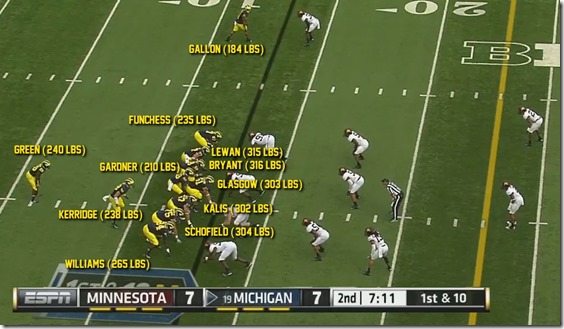big formations
That is 2,728 pounds—1.24 metric tons—in the box for those weighing at home.
On 1st and 10. MANBRAAAHHHLLL!!!
Before the Minnesota game I tweeted that I'd be perfectly content if Borges debuted a completely new package and used it to beat up on the Gophers at home a la 2011. So here I am, being content.
The unbalanced stuff I'm sure Brian will picture page and Space Coyote and Burgeoning Wolverine Star will peel it apart as well; since they know more about that stuff I'll leave it to them. What I would like to do is look at the heavy formations in the macro: how Big did Michigan actually go, how effective it was on a yards-per-play basis, and whether it matches the personnel.
By "big" I mean fewer receivers in the formation. The lower that number, the more backs and TEs, and thus the "heavier" the formation. How big?
Average Receivers in Formation:
| Season | Overall | Normal downs* |
|---|---|---|
| 2008 | 3.14 | 3.14 |
| 2009 | 2.84 | 2.90 |
| 2010 | 3.13 | 3.15 |
| 2011 | 2.59 | 2.60 |
| 2012 | 2.52 | 2.55 |
| 2013 games 1-4 | 2.30 | 2.29 |
| 2013 Minnesota | 1.83 (!) | 1.79 (!) |
That is big—like we should all have pronounced brow ridges and live in caves and the equipment sponsor is Mousterian big. I counted Funchess as a WR when he was in a 2-point stance; if you file him as a half tight end (you shouldn't) it gets even heavier. A lot of the three-wide was on the time-sensitive last drive of the 1st half—that you should count.
Did it work? Did it work better than the stuff Michigan has been doing until now? Did they always run to the side they unbalanced? We see after the jump.

17